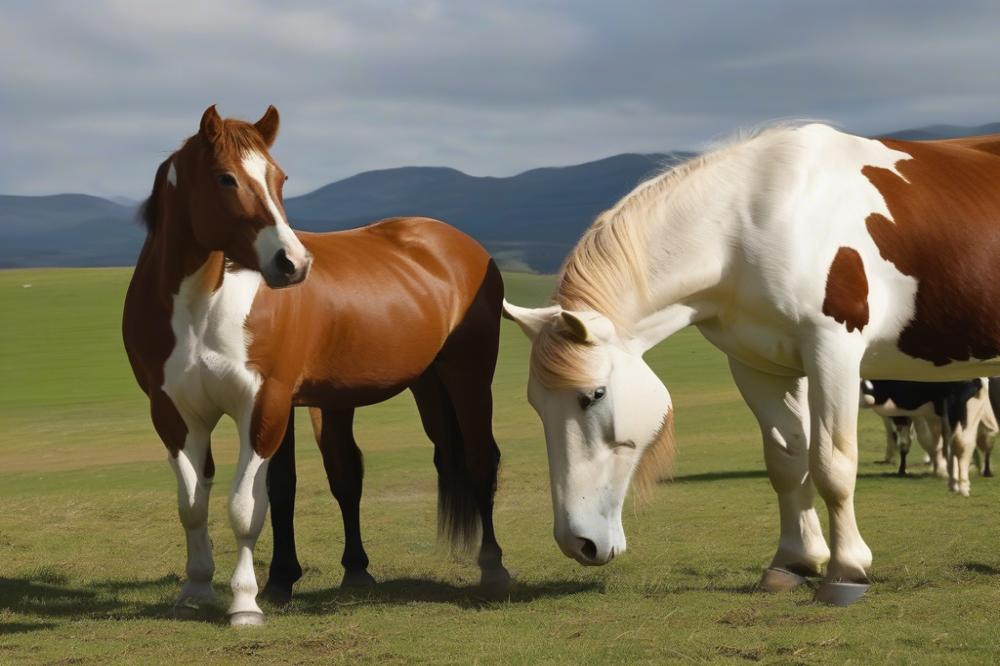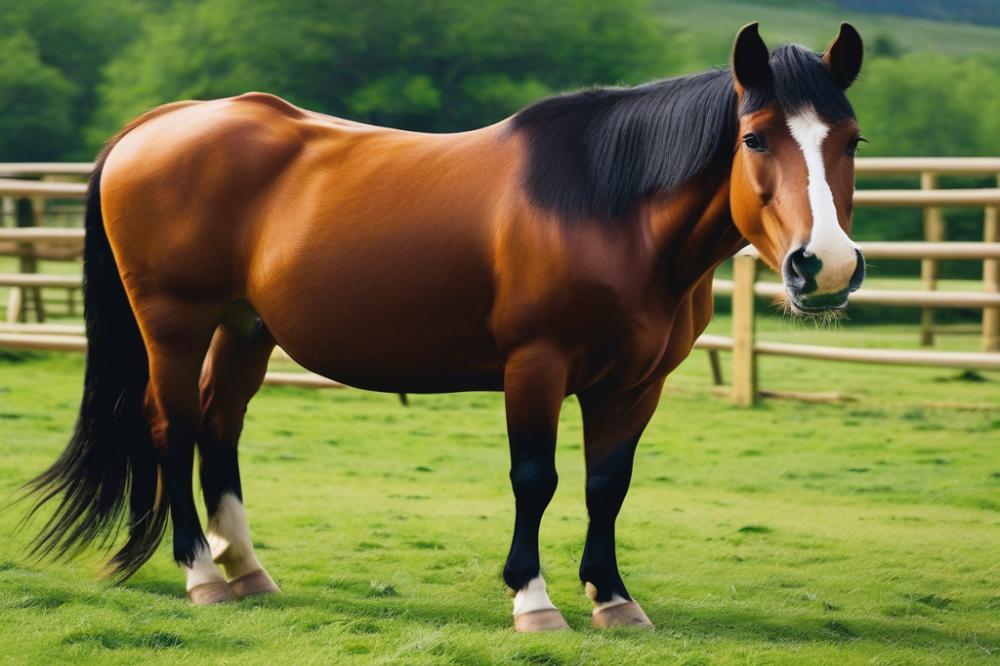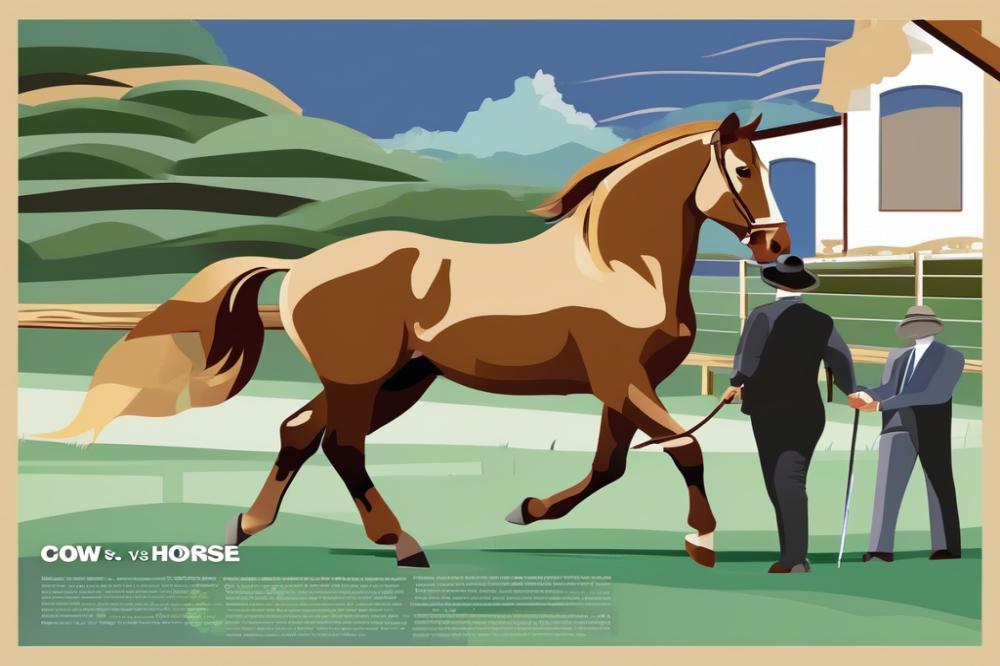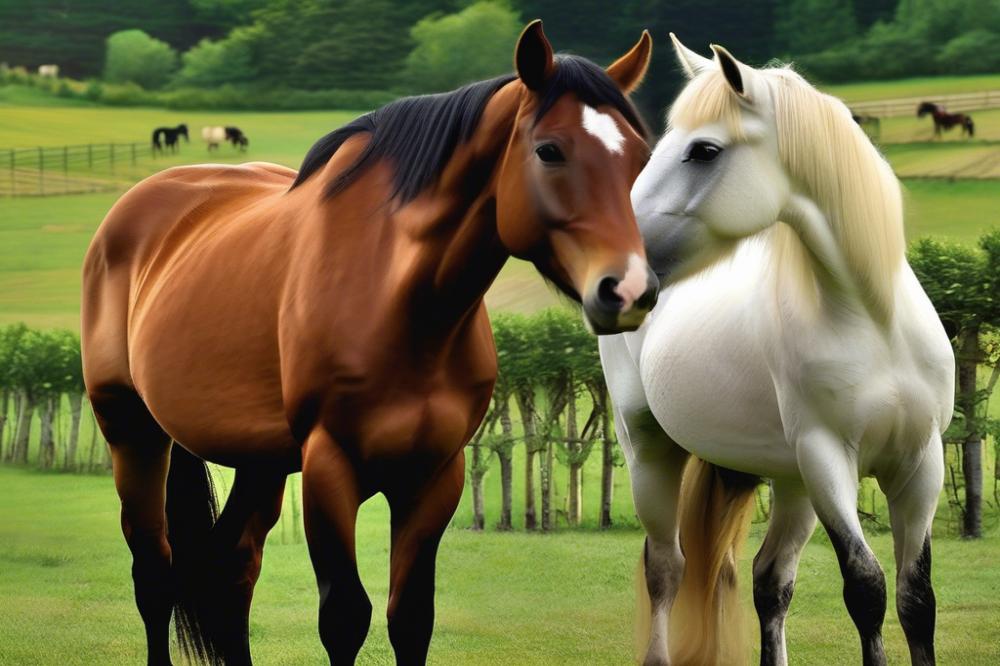Understanding Cows and Horses
Cows and horses are two of the most common domesticated animals that humans have relied on for centuries. They both play vital roles in agriculture and culture, but they couldn’t be more different in terms of their characteristics and abilities. Each has cast its own shadow on farming practices around the world. There’s a saying that cows are the gentle giants of the farm while horses are the spirited companions that carry us to new adventures. Even at a glance, one can see the distinct nature of these two animals.
In terms of agriculture, cows are treasured for their milk, meat, and leather. Farmers often focus on cow care to ensure these bovine friends stay healthy and productive. Meanwhile, horses are valued for their speed, strength, and companionship. They bring joy to lives through leisure activities, work on farms, and their amazing equine characteristics. It’s fascinating how the roles of these animals evolved but still remain influential in our daily lives.
When we think about horse care, it’s not just about grooming and feeding. There is a dedicated approach behind nurturing these magnificent animals, including understanding different breeds of horses that exist. Just like people, horses have their own personalities and quirks, which makes getting to know them a delightful experience. Cows, too, have their own set of behaviors, often seen lounging peacefully in pastures or curiously roaming their surroundings.
As we dive deeper into the comparison of these beloved creatures, it’s worth noting that the question ‘is horse a pet animal‘ often arises. Yes, a horse can certainly be a pet, but it involves more commitment than one might first think! Both animals contribute significantly to our lives, shaping our agricultural practices and cultural expressions. So, buckle up as we explore the wonderful world of cows and horses, their care, and what makes each of them stand out.
Physical Characteristics

Comparison of Size and Weight
Cows and horses vary a lot when it comes to size and weight. A healthy cow often weighs between 1,000 and 1,800 pounds. In contrast, horses can weigh anywhere from 800 pounds to over 2,200 pounds. Imagine trying to lift a heavy suitcase. That’s similar to the difference between these two animals. Some horse breeds are just massive, while others are more petite. The sheer difference makes them stand out in any farmyard.
Differences in Body Structure
Body structure is where things get interesting. Horses have long legs and thinner bodies, perfect for running and jumping. Their skeletal structure helps them hold speed over distances. Cows, on the other hand, are stocky and built for strength. Their legs may not be as long, but they are sturdy, which allows them to support their hefty weight. Think of the strong oak tree next to a tall, swaying palm. Both are impressive, but each serves a different purpose. Those equine characteristics allow horses to excel in racing, while bovine characteristics give cows an edge in adaptability to tough conditions.
Coat Color and Types
When it comes to looks, cows and horses flaunt a variety of coat colors. Horse coats can be bay, chestnut, gray, or even spotted! Many people love to see a dappled gray horse trot by. Cows, in their own right, present an array of shades, from black and white Holsteins to the rich browns of Jerseys. The patterns on a cow’s coat can be as varied as a patchwork quilt. Animal comparison here reveals how each type expresses its identity. With horse care, grooming can display beautiful shine and make those colors pop. For cows, their coats signify more than beauty; they relate to heat regulation and overall health.
Behavior and Temperament

General behavior of cows
Cows have an interesting way of moving through life. They seem calm much of the time, stopping to munch on grass and occasionally mooing like they’ve got secrets to share. These animals often prefer to stay together. When one cow finds a tasty patch of grass, others will typically follow suit. Their grazing isn’t just for food; it’s also a social event. Cows communicate using a variety of sounds. They also tail-swat to signal discomfort or irritation. So, if you see a cow flicking its tail, take note!
General behavior of horses
Horses, on the other hand, exhibit more energy. With their keen instincts, they are often alert and aware of their surroundings. Grazing is a part of their routine too, but they’re much quicker to trot off if they feel unsettled. Their powerful legs are built for running, which explains why they might dart away from a perceived threat. Horses enjoy interacting with humans and can bond closely with their caregivers. Grooming sessions may even lead to playful nipping or gentle nudging, showcasing their affectionate side.
Social structures and herd dynamics
Cows have a well-established social hierarchy. Each cow knows its place in the pecking order, which can change over time. The alpha cow usually leads the group, guiding where they go for food and water. In a herd, it’s common to see them establish bonds, often grooming each other to strengthen their friendship. With horses, the dynamics can shift dramatically. They form tight-knit groups but are not as rigid in hierarchy. A dominant horse might take the lead, but each member knows its personality. Horses can be playful and sometimes even silly, engaging in games of chase or rolling in the grass.
In an animal comparison, cows and horses show distinct behaviors. While both species are herding animals, their social interactions reflect unique traits. Horse care often involves training and discipline, focusing on the horse’s remarkable abilities. Conversely, cow care emphasizes comfort and familiarity, making it vital to understand bovine characteristics. Horses and cows manage their social networks differently, yet both aspire for harmony within their herds.
Diet and Feeding Habits

Typical diets of cows
Cows primarily munch on grass and hay. These animals are ruminants, which means they have a special stomach designed for breaking down tough plant materials. They spend a significant part of their day grazing in fields, chomping away. Grains and silage can also make up some of their diet, especially when farmers want to ensure they get enough energy. Cows are social eaters, often found in groups, chatting while they snack. Think of it as a buffet where they savor every bite.
Typical diets of horses
On the other hand, horses enjoy a variety of foods. Hay is essential for them too, but they can also nibble on grains like oats and barley. Fresh grass is a favorite treat, especially in the spring. Horses have a unique digestive system that requires them to eat small amounts frequently. They are trickier eaters than cows, often preferring certain flavors and textures. Ever watch a horse pick at its food? It’s like they’re savoring a fine dining experience.
Digestive systems and feeding methods
The differences in digestion are quite fascinating. Cows have a multi-chambered stomach that ferments food, breaking it down more thoroughly. They bring their food back up to chew again, a process known as “cud chewing.” This helps them get the most energy from their meals. Horses, in contrast, have a single-chambered stomach. Their digestive system works best when they have access to food throughout the day. Rushing through meals can cause serious issues for them.
When comparing horse care to cow care, it’s essential to consider these differences. An empty hay rack will get a horse anxious. Just like humans, hungry animals can get cranky. For cows, having a steady supply of grass ensures they are satisfied. Owners must understand these unique needs to keep their animals happy and healthy. Both animals exhibit their own distinct nutritional requirements, highlighting their animal abilities in different ways.
Roles in Agriculture and Industry
Cows’ Contributions to Dairy and Meat
Cows play a tremendous role in agriculture by providing dairy and meat. Milk from cows fuels breakfast tables everywhere. We enjoy cheese, yogurt, and ice cream, all thanks to their generous contributions. Without these animals, many favorite meals would be very different. Beef is another key product that comes from cows, making them a staple in many diets. Their ability to convert grass into protein is truly remarkable. In the world of animal comparison, few other creatures can match this efficiency.
Horses’ Roles in Transportation and Work
Horses have a storied history in transportation. Before cars and trucks existed, they were the prime movers on farms and in towns. People relied on horses for riding and pulling carts. Their strength and speed made them vital for getting things done. Even today, many ranchers depend on horses to help with herding cattle. During rodeos and equestrian events, their athletic talents shine. Horse care is just as vital as cow care. Both require attention, but the needs differ greatly due to their unique characteristics.
Comparative Economic Impacts of Cows and Horses
When considering economic impacts, cows and horses offer different benefits. Cattle farming is a massive industry worldwide. It supports millions of jobs and contributes significantly to the economy. The dairy sector, in particular, is a powerhouse. Horses, while not as common in the food industry, play a role in tourism and recreation. Think of all the horse-drawn carriages in cities or the horseback rides available at vacation spots! Yet, both animal abilities and their contributions have lasting effects on local economies.
Each animal brings its own set of advantages and challenges. Understanding these helps clarify their roles in agriculture and industry.
Cultural Significance
Symbolism of Cows in Various Cultures
Cows hold a special place in many societies. In India, they’re considered sacred and often roam freely. People often view them as symbols of motherhood and nurturing. The gentle nature of these animals contributes to this. Their milk sustains many families, making them vital in daily life. In some cultures, cows represent wealth and prosperity. Farmers prize them for their ability to provide resources.
In ancient cultures, like those of the Egyptians, cows were revered too. They associated these animals with fertility and abundance. Statues of cow goddesses remind us of this connection. The relationship between humans and cows can be deep and meaningful. Additionally, in the Hindu festival of Gopashtami, cows get special attention and care. This emphasizes their important role in agricultural societies.
Symbolism of Horses in Various Cultures
Horses also have rich symbolism across the globe. They often represent strength, freedom, and nobility. Throughout history, warriors rode horses into battle, signifying power and bravery. In Native American culture, the horse symbolizes a connection to the spirit world. These animals helped communities thrive by transforming how they traveled and hunted.
In some fairy tales, horses are magical creatures. They possess qualities beyond the ordinary, showcasing beauty and grace. Think of the famous tales like “The Trojan Horse.” Clearly, horses capture the imagination of storytellers and artists alike. Similarly, the Spanish consider the Andalusian horse a symbol of elegance and pride. This cultural appreciation demonstrates the diverse perspectives on horses.
Perspective in Art, Literature, and Folklore
Art has long celebrated both cows and horses. In many paintings, cows reflect pastoral life. They are often painted in peaceful rural settings. Artists like Claude Monet captured their essence beautifully. Horses appear in various artworks too, from ancient sculptures to modern paintings. Their dynamic form conveys motion and spirit, making them a cherished subject for many creators.
Literature also features these two animals prominently. Consider how many times horses appear in classic novels. They carry heroes on great adventures, like in “Black Beauty.” Cows show up often in children’s stories, teaching lessons about kindness or farm life. Folklore allows these animals to take on unique roles. In some tales, cows serve as wise advisors, while horses often have heroic destinies.
Understanding the symbolism and representation of cows and horses opens a window to our own human experience. Each creature reflects different traits and values. As we dig deeper into this animal comparison, it becomes clear that they enrich our lives in countless ways. Both horse care and cow care are significant, emphasizing the bond humans share with these animals. Appreciating their characteristics helps us respect their place in our cultures.
Health and Care
Common Health Issues for Cows
Cows face a variety of health issues. Bovine characteristics include being prone to diseases like mastitis. It’s an infection of the udder that can hurt milk production. Another issue is bloat, a painful condition caused by gases building up in the stomach. Regular check-ups help catch these problems early. Cows can also suffer from foot rot, which makes walking quite painful. Farmers often keep an eye out for limping or swelling to prevent this.
Also, a cow’s diet plays a huge role in health. Poor nutrition can lead to metabolic disorders. These issues can sneak up if farmers don’t pay attention. Parasites like worms are also common. Keeping pastures clean and rotating them can minimize these pests. It’s essential to monitor a herd’s well-being closely to avoid bigger troubles down the line.
Common Health Issues for Horses
Horses are stunning animals with their own set of health challenges. Equine characteristics often lead to disorders like colic, a serious stomach condition. Signs include rolling or pawing at the ground. Quick action can be lifesaving. Injuries to legs and hooves happen because horses are active creatures. Regular hoof care and shoeing help prevent many of these problems.
Respiratory issues also plague these graceful animals. Dusty environments can trigger coughs and other complications. Ensuring clean and comfortable stabling can improve their quality of life. Equine arthritis becomes more common as horses age, affecting their ability to move freely. Caring for their joints with proper nutrition and exercise can make a big difference.
Basic Care and Management Requirements
Both animals require thoughtful care. Cow care often involves regular feeding and clean living spaces. They need access to fresh water, proper shelter, and room to roam. Routine vaccinations are also vital. Farmers should maintain a schedule for veterinary visits to keep their herd in tip-top shape.
Horse care involves grooming, riding, and socializing. Their minds and bodies thrive when they’re active. With this in mind, stalls must be kept clean and provide safe environments. Feeding requires attention, too. Horses need a balanced diet rich in fiber. Grains can be beneficial, but too much can cause trouble. Remember, a bored horse can be an unhealthy horse; sometimes they need toys to keep them entertained.
In this animal comparison, both cows and horses share the need for regular care, though their requirements differ based on characteristics. Whichever animal one decides to care for, commitment is essential. It’s about patience, love, and understanding their unique needs.
Final Thoughts
As we wrap up our exploration of cows and horses, it’s clear that both animals bring something special to our lives. On one hand, we have the cow, a gentle giant that provides milk, meat, and even leather. On the other hand, the horse, often seen galloping through fields, offers companionship, labor, and a connection to nature that’s hard to replicate. They both hold a unique place in agriculture and recreation, serving different but equally important roles. One might say they complete a wonderful circle of life!
Similarities between these two animals are striking when you take a closer look. Both are domesticated and have been serving humans for thousands of years, whether on the farm or in transportation. Both can be trained, and they often rely on their human caretakers for food and shelter. Thinking about their differences, cows might prefer their cozy pastures, while horses thrive in wide-open spaces where they can roam, much like a kid running free at recess. One can also relish the laughter and joy horses bring during a ride or the quiet contentment of watching cows grazing at sunset.
Reflecting on the importance of these animals leads to a deeper appreciation of the roles they play. The cow is often seen as a staple, grounding us with its nurturing nature, while the horse inspires us, sparking dreams of freedom and adventure. Who hasn’t daydreamed about galloping through fields or finding a calm spot to watch cows? Each offers us lessons in loyalty, hard work, and patience. A friend once said that owning a horse can be a bit like having a second job. Yet, every challenge is accompanied by the joy of the bond formed along the way.
As we embrace the richness that both animals add to our lives, let’s take a moment to appreciate their distinctiveness. Whether it’s the draft horse price that reflects their vitality or the horse habitat that fosters their spirit, both creatures enrich our days in ways we often overlook. So, the next time you come across these marvelous beings, pause for a moment. Enjoy their presence and all they contribute to our world, creating a delightful tapestry of life on earth!



